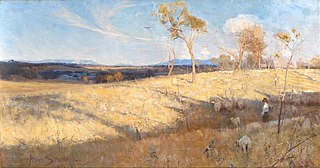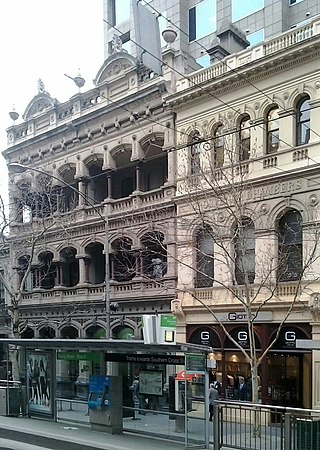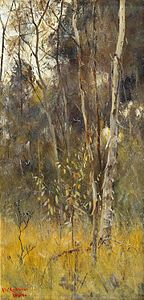
The Victorian Artists Society, which can trace its establishment to 1856 in Melbourne, promotes artistic education, art classes and gallery hire exhibition in Australia. It was formed in March 1888 when the Victorian Academy of Arts and the Australian Artists' Association amalgamated.

The Heidelberg School was an Australian art movement of the late 19th century. It has been described as Australian impressionism.

Frederick McCubbin was an Australian artist, art teacher and prominent member of the Heidelberg School art movement, also known as Australian impressionism.

Thomas William Roberts was an English-born Australian artist and a key member of the Heidelberg School art movement, also known as Australian impressionism.

Charles Edward Conder was an English-born painter, lithographer and designer. He emigrated to Australia and was a key figure in the Heidelberg School, arguably the beginning of a distinctively Australian tradition in Western art.

Sir Arthur Ernest Streeton was an Australian landscape painter and a leading member of the Heidelberg School, also known as Australian Impressionism.

Clara Southern was an Australian artist associated with the Heidelberg School, also known as Australian Impressionism. She was active between the years 1883 and her death in 1940. Physically, Southern was tall with reddish fair hair, and was nicknamed 'Panther' because of her lithe beauty.

Jane Sutherland was an Australian landscape painter who was part of the pioneering plein-air movement in Australia, and a member of the Heidelberg School. Her advocacy to advance the professional standing of female artists during the late nineteenth century was also a notable achievement.

Walter Herbert Withers was an English-born Australian landscape artist and a member of the Heidelberg School of Australian impressionists.

Grosvenor Chambers, at number 9 Collins Street, Melbourne, contained the first custom-built complex of artists' studios in Australia.

The 9 by 5 Impression Exhibition was an art exhibition held in Melbourne, Victoria, Australia. It opened on 17 August 1889 at Buxton's Rooms on Swanston Street and featured 183 "impressions", the majority of which were painted by Charles Conder, Tom Roberts and Arthur Streeton, three leading members of the Heidelberg School art movement, also known as Australian impressionism. Two other members, Frederick McCubbin and Charles Douglas Richardson, made smaller contributions.

David Davies was an Australian artist who was associated with the Heidelberg School, the first significant Western art movement in Australia.

A holiday at Mentone is an 1888 painting by Charles Conder, a leading member of the Heidelberg School movement, also known as Australian impressionism. It depicts people engaged in seaside activities on a sunny day at Mentone Beach, in the Melbourne suburb of Mentone.
One Summer Again is a 1985 Australian docudrama miniseries about the painter Tom Roberts and the Heidelberg School art movement. Set in and around the city of Melbourne in the late 19th century, the film traces Roberts' career and his relationships with other members of the Heidelberg School, including Arthur Streeton, Charles Conder and Frederick McCubbin. Their artists' camps are recreated in authentic bush settings, which one critic described as having "the soft warmth of a McCubbin painting". Film sets true to the period are contrasted with shots of contemporary Melbourne.

Mentone Beach is a beach located in Mentone, on Port Phillip Bay, Victoria, Australia, 21 kilometres south from the Melbourne City Centre. Mentone beach is the northern section of a beach that extends alongside Beaumaris Bay from the cliffs at Rickett's Point in Beaumaris to Frankston in the south on the eastern shoreline of Port Phillip Bay.

Leon Pole was an Australian artist who was associated with the Heidelberg School art movement, also known as Australian Impressionism.

Louis Abrahams was a British-born Australian tobacconist, art patron, painter and etcher associated with the Heidelberg School art movement, also known as Australian Impressionism.

The Exhibition of Australian Art in London was a show organised by the trustees of the Art Gallery of New South Wales (AGNSW), notably Julian Ashton, and financially supported by the philanthropist Eadith Walker. Held at London's Grafton Galleries between April and September 1898, it featured 371 artworks made in Australia by 114 artists, and was the first major exhibition of Australian art to occur internationally.

Thomas Humphrey was a Scottish-born Australian artist and photographer who was associated with the Heidelberg School art movement, also known as Australian impressionism.
Jane Rebecca Price was an Australian painter who was a foundation member of the Melbourne Society of Women Painters and Sculptors. Two of her works have been acquired by the National Gallery of Victoria and two by the Art Gallery of South Australia. She was a close associate of members of the group of painters known as the Heidelberg school.





































